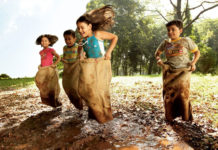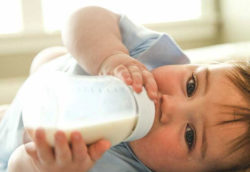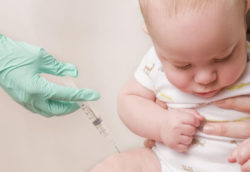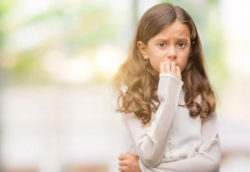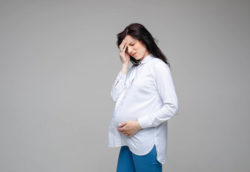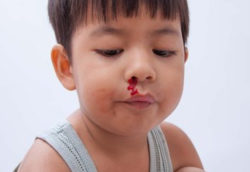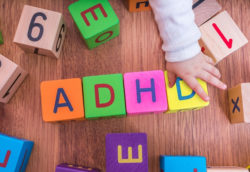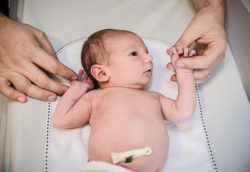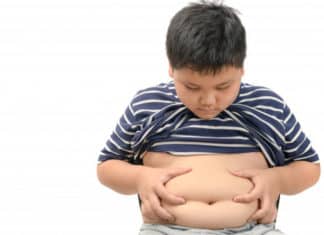Seeing the blood in your child’s stool can be frightening and alarming. However, this is a common condition in children and is usually not serious. Seeing the slightest streak of blood in your child’s stool can make a mother panic. Blood in stool is a sign of any digestive trouble or gastrointestinal infection in kids.
There are many possible causes behind bloody stools, which is also known as “rectal bleeding.” The most likely cause depends on the frequency and amount of blood, and as per your child’s age and underlying condition. A health care provider can help you to determine the source of the bleeding and the most appropriate treatment for blood in child stool(R).
In this article, we will focus on the causes, symptoms, and some of the home remedies for blood in stool in children. We will also focus on the tests that may be used to evaluate your child.
Rectal Bleeding in Children:

It is very true that seeing blood in your child’s stool can be quite frightening and stressful. But, let me tell you it will give you some peace of mind to know that 9 out of 10 times, this is something very temporary and common, it does not indicate anything serious in your kid’s health.
Blood in the stool or rectal bleeding can occur due to a myriad of reasons, it all depends on the frequency and the amount of blood as per the age of your child which will determine the seriousness of the condition.
The color of blood in stool usually look like bright red or maroon-colored poop which indicates a lower source of bleeding such as from the large intestine. Black or very dark-colored poop (R) indicates a higher source of bleeding such as from the esophagus, stomach, or small intestine.
Foods such as tomatoes, beets, red Kool-Aid, and red velvet cake can cause the stools to become red and give the false appearance of blood in the poop. Some medicines, such as the common childhood antibiotic Omnicef, can also cause the poop to turn red. Chocolate, iron supplements, and blueberries can often make the poop look very dark or black too.
Types of Rectal Bleeding:
Bloody stools in a child (R) usually indicate bleeding in the upper digestive tract which includes stomach and small intestine and/or the lower digestive tract which covers the colon, rectum, and anus.
- The bleeding from the upper digestive tract usually causes black, tarry stools. In most of the cases, the child also vomits red or black material that looks like coffee grounds.
- Bleeding from the lower digestive tract usually causes the stool to be coated or mixed with bright red blood, or occasionally to appear maroon colored.
- Certain foods and medications(R) can also cause the stool to appear bloody stool in children. To check the list of food that causes toddlers blood in the stool can refer to
What Causes Blood in Stool in Children?
As we discussed above, the cause depends on the frequency and amount of blood, and as per your child’s age and underlying condition. A health care provider can help you to determine the source of the bleeding and the most appropriate treatment for blood in child stool.
Let us focus on some of the underlying causes of bloody stool in children.
1. Anal Fissure:
An anal fissure is a cut or tears in the lining of the anus in which the opening through which stool passes out of the body. This is more developed when an infant or child passes a large or hard stool. Anal fissures (R) can occur in all age groups, from newborns to school-aged children and even adults. It occurs in 90% of children with blood in the stool.
The symptoms of an anal fissure include pain, straining, or grunting during a bowel movement, and bright red blood on the outside of the stool. Many infants and toddlers with anal fissures also have a history of constipation or hard stools.
2. Milk or soya Protein Intolerance:
Milk or soy protein intolerance is also known as milk- or soy protein-induced colitis, or protein that induced proctitis or proctocolitis. This is a condition that can develop in infants and result in rectal bleeding. It is mostly caused by a sensitivity to the protein in cow’s milk or soy protein and usually develops after starting formula food to kids. It can also occur in breastfed infants, as cow’s milk or soy products are consumed by the mother’s diets. The protein intolerance frequently resolves by one year of age of your child.
The symptoms of milk or soy protein intolerance may include vomiting and diarrhea, in addition to blood-tinged or bloody stools. If milk or soy protein intolerance seems to be the most likely cause after an evaluation by the medical provider, a diet that does not contain milk or soy protein is often prescribed.
3. Inflammatory Bowel Diseases:
Most children suffer from Inflammatory Bowel Syndrome(IBS). Inflammatory bowel disease is also known as Crohn disease or ulcerative colitis, which is a chronic inflammatory condition in which the lining of the digestive tract becomes an inflamed and irregular fashion that results in diarrhea as well as constipation. The inflammation bowel moment leads to symptoms such as bloody stools, diarrhea, lack of appetite, weight loss and abdominal pain. Up to around 25 percent of cases of inflammatory bowel, diseases are diagnosed in people younger than 20(R), as reported in a November 2015 “JAMA Pediatrics” review article. IBD is most frequently diagnosed in adolescents but can occur in younger children.
4. Infectious Diarrhea:
Infectious diarrhea is diarrhea that is caused by a virus, bacterium, or parasite. This can cause bloody stools in child ranging from preschool and school-aged children, and as well as in adolescents. Infectious diarrhea can develop as a result of eating or drinking contaminated foods, drinks, water or taking a course of antibiotics. Symptoms of infectious diarrhea usually include bloody diarrhea, fever, and abdominal pain. Infectious diarrhea(R) also cause Shigella, Salmonella, E.Coli 0157 or Campylobacter.
5. Meckel’s Diverticulum:
Meckel’s diverticulum is congenital which is present at the birth of a child and outpouching in the lower part of the small intestine and is leftover from the umbilical cord during the birth of a child. It may contain cells normally found in the stomach that can secrete acid and cause ulcers, bleeding in the small bowel near the diverticulum. bleeding from a Meckel’s diverticulum can be dangerous. Meckel’s diverticulum condition sometimes causes episodic, painless bloody stools particularly mainly among children younger than 5, than of older children are affected. The problem with diverticulum resolves by surgery.
6. Juvenile Polyps:
Juvenile polyps are defined as a tissue which is projecting from the inner lining of the colon develop in children, mostly between the ages of two and ten years. Symptoms usually include painless rectal bleeding in children. the Single juvenile polyps are not usually cancerous or precancerous but should be evaluated by a health care provider and usually require removal.
Rarely the multiple or large polyps are present in the colon of children or adolescents that cause rectal bleeding. Some of the conditions associated with this presentation in children and teenagers are juvenile polyposis(R) coli (JPC), adenomatous polyposis coli (APC), or Hereditary nonpolyposis colon cancer (HNPCC) syndrome (formerly known as Lynch syndrome). These conditions are often inherited and patients often have family members who are affected
Symptoms of Blood in Stool in Children:
Blood in the stools is the most common symptom. This type of bleeding is referred to as occult bleeding and the pediatrician will be able to diagnose with a simple stool examination. The doctor can consider or figure out for other symptoms as well apart from rectal bleeding. Along with rectal bleeding, there are symptoms such as changes in bowel movements and pain or tenderness while passing stools. It also includes abdominal pain, diarrhea, fever, vomiting too.
When to Seek a Medical Attention:
When the home treatment or remedies do not work, it is always best to seek medical advice to treat the problem of a bloody stool in children. If you notice any of the following signs, then do consult a doctor immediately.
- The Anal area is physically injured.
- Intense pain in the abdomen area and bloody vomiting
- Consistently of dark-colored stools with a lot of blood
- The child is ill and has a fever.
- In excessive diarrhea.
Blood in stools in children needs a careful evaluation only if it is something that is a consistent issue or problem with your child. Moreover, if something that is persistent, you can practice some home remedies and take care that your child should consume some fiber-rich food in his/her diet. This will prevent hard stools and reduce the chances of rectal bleeding that can be due to anal fissures in your child.




